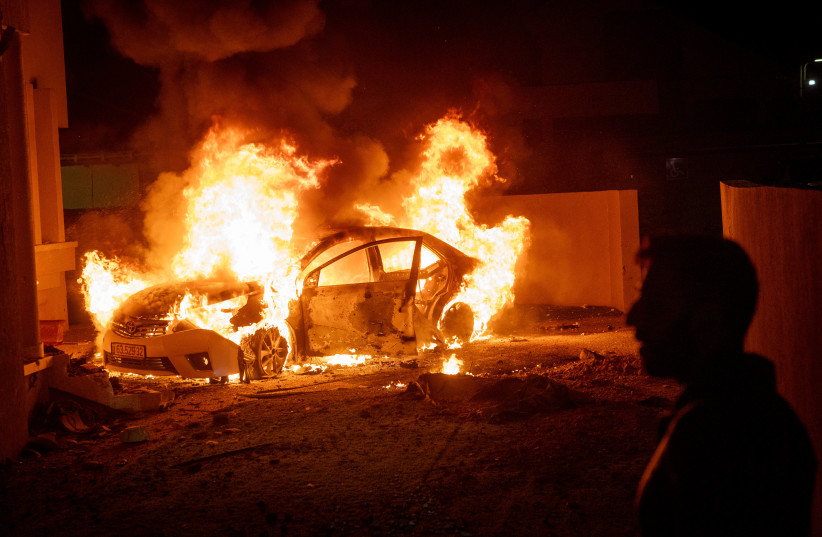Heinrich Heine is generally credited with saying that “where they burn books, they will ultimately burn people.”
Growing up in the United States, I was taught that Heine’s statement was to some extent a prophecy of the Holocaust.
In 1933, the Nazis engaged in a mass burning of books, many written by German Jews. Five years later, in November 1938, the Nazis incited Kristallnacht, a nationwide series of pogroms that included the burning of synagogues and Torah scrolls. A mere three years later, the Nazis embarked on the Final Solution, which literally included the burning of the bodies of millions of Jews.
When I was taught that Heine’s statement was a prophecy of the Holocaust, little did I think that I would live to see that horrific prophecy repeated in my lifetime – about an hour’s drive from my home in Israel.
Israel was in control of the Gaza Strip (which it captured in a war of self-defense) from 1967 to 2005. Starting in 1967, Israeli civilians lived in 20 different communities set up by the Israeli government in the Gaza Strip.

Israel made a unilateral withdrawal from the Gaza Strip in 2005. It decided to withdraw from the Gaza Strip, in the hope of achieving peace with the approximately 1.4 million Arabs living in Gaza – to end the so-called “occupation.” The decision to withdraw created a great schism in Israeli society and caused over 8,000 Israelis to be uprooted from their homes.
As the final stages of the uprooting process were nearing, the Israeli government had not yet decided what to do about the synagogues that had been built and used in the Jewish communities in Gaza. At the 11th hour, it was decided that, although all Torah scrolls and books would be removed, Israel would not destroy the empty synagogues. Therefore they were left standing.
Israel hoped, naively, that the Gazan populace would respect their status as houses of worship. However, on September 12, 2005, the international media reported that one of the first things that happened after the withdrawal of the last Israeli forces from Gaza was that Palestinian Arabs set fire to three synagogues.
Israel’s then-foreign minister, Silvan Shalom, condemned the acts of arson, calling them a “barbaric act by people who have no respect for holy sites.” He was right.
From burning synagogues to burning Jews alive
Unfortunately 18 years later, decent people worldwide would use the same word “barbaric” to describe the torching of human beings on October 7, 2023.
How did the world in 2005 react to the torching of synagogues in broad daylight? The Palestinian Authority issued no statement of condemnation. The rest of the world was largely silent. Israel’s Arab neighbors – including Egypt and Jordan – failed to condemn these acts.
What about Muslim religious leaders? In evaluating their conduct (or inaction), the historical context is important.
IN THE weeks and months after the September 11, 2001 attacks on the United States, Muslim leaders throughout the world proclaimed that Islam is a religion of love, that Islam abhors violence, and that Muslims respect other monotheistic religions. A mere three years after 9/11, when Arabs in Gaza were burning synagogues, where were those same Muslim leaders? If any of those Muslim leaders expressed any condemnation, they must have done so in a whisper.
When Heine said “Where they burn books, they will ultimately burn people,” his use of “ultimately” was not superfluous. The burning of books or buildings is usually frowned upon. The people who, nonetheless, do engage in such arson make a statement, and – whether consciously or not – they are testing the rest of society.
If society at large condemns the burning of books, then the people who committed such acts of arson will, in essence, be marginalized. But when society at large does not condemn the burning of books, and when the people who committed those crimes are not marginalized, then they become empowered to commit even more heinous crimes of hate.
And so it was with the Nazis. In 1933 and 1938, they engaged in the widespread burning of books and property of Jews. By late 1941, the first gas chambers were constructed.
From 1938 through 1941, the Nazis paid attention to how the rest of the world reacted – more accurately, failed to react – to the persecution of European Jewry.
Perhaps the most public example was the MS St. Louis, which sailed in 1939 with almost a thousand Jews, and was denied entry into Cuba, then into the US, and then into Canada. Everyone knew that the passengers on the MS St. Louis were escaping persecution from the Nazis, and the Nazis saw that much of the world did not care.
No more than two years later – a short “ultimately” to which Heine had referred – the Nazis were confident that the world would tolerate the deportation of Jews to death camps where their bodies would be burned. Unfortunately, the Nazis did not misread the rest of the world.
Fast forward to 2005. When society at large does not condemn the burning of synagogues, and when the people who commit those crimes do not become marginalized, then those who burn synagogues become empowered to commit even more heinous crimes of hate.
Arabs who live in Gaza burned synagogues in 2005, and they saw – from a largely silent world – that they could get away with it. It should not have been a surprise to anyone that burning Jews alive would be next on their agenda.
The writer is an American-Israeli lawyer based in Ramat Gan. He serves as vice chair of the American Bar Association’s International Litigation Committee and has held other positions with the ABA.
